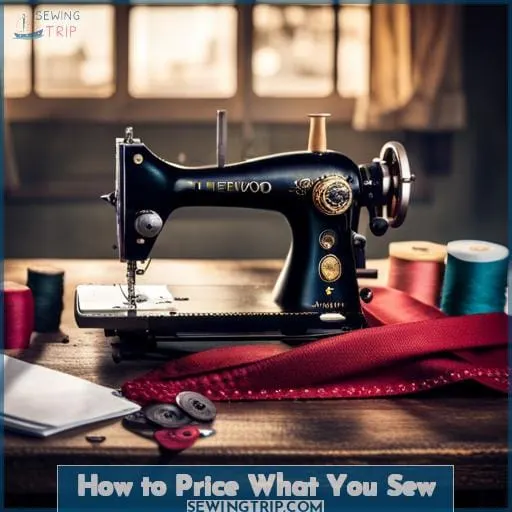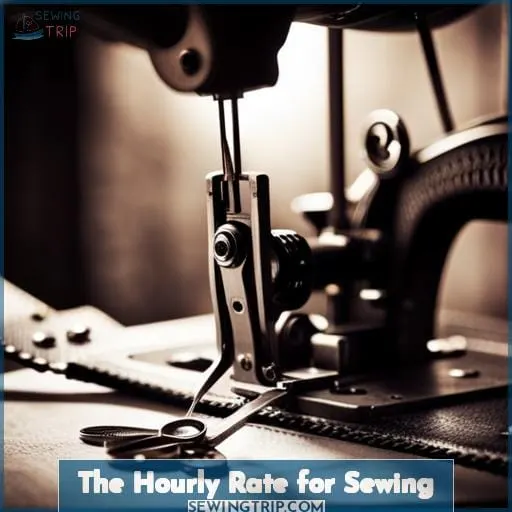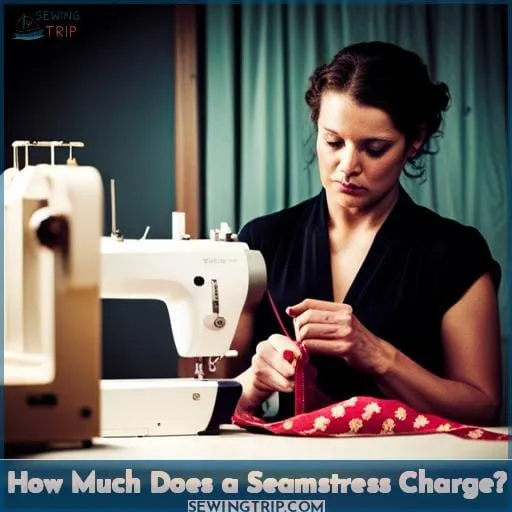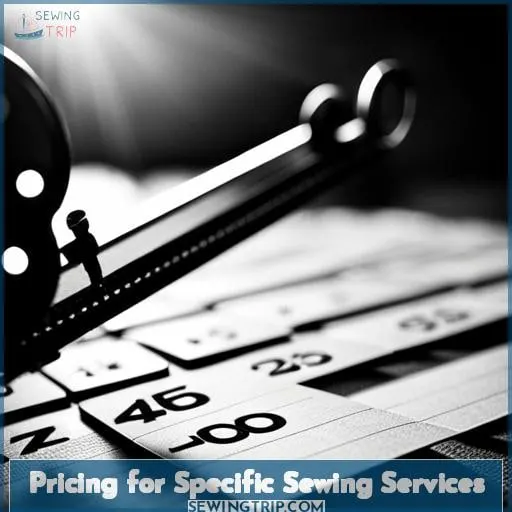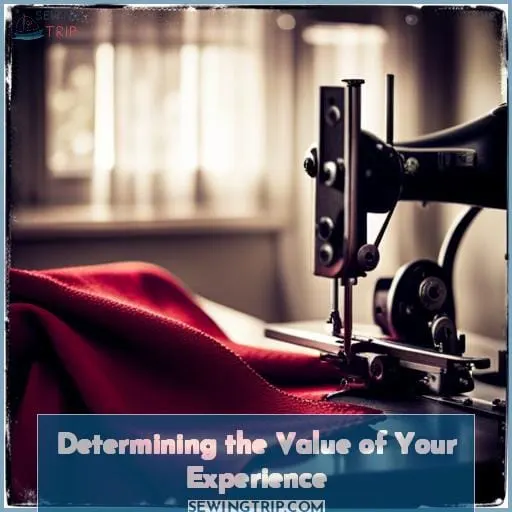This site is supported by our readers. We may earn a commission, at no cost to you, if you purchase through links.
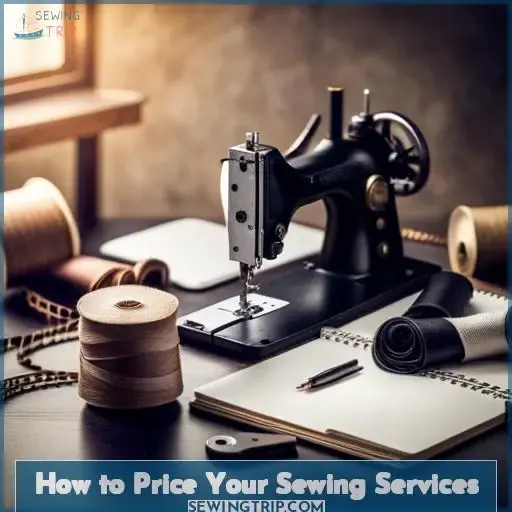 Ready to take your sewing skills to the next level and start charging for your services? Pricing can be a daunting task, but don’t worry – we’ve got you covered.
Ready to take your sewing skills to the next level and start charging for your services? Pricing can be a daunting task, but don’t worry – we’ve got you covered.
From determining your hourly rate to factoring in supply costs, we’ll help you find the perfect balance between fair compensation and attracting customers.
Table Of Contents
- Key Takeaways
- Where to Start
- Who is My Customer?
- What Are My Supply Costs?
- How Much is My Time Worth?
- Putting It All Together
- How to Price What You Sew
- The Hourly Rate for Sewing
- How Much Does a Seamstress Charge?
- Pricing for Specific Sewing Services
- Determining the Value of Your Experience
- Frequently Asked Questions (FAQs)
- Conclusion
Key Takeaways
- Identify your target customer
- Calculate your supply costs
- Determine how much your time is worth
- Put it all together
Where to Start
To start pricing your sewing services, assess the various factors that contribute to the overall cost and value of your work.
- Understanding your clients is key in determining how much they’re willing to pay for custom sewing projects.
- Consider their preferences, budget constraints, and desire for quality when setting prices.
Next, break down the costs involved in providing your services.
- This includes fabric types (high-end, mid-range, or budget),
- Additional materials like zippers or trims,
- As well as any other direct expenses such as machine maintenance or electricity usage.
Service differentiation is another crucial aspect to consider.
- Conduct a market analysis to understand what similar services are being offered by competitors and at what price points.
- This will help you develop effective pricing strategies that align with industry standards while also taking into account the unique value you bring to each project.
Creating a custom sewing price list can streamline the process of charging for different tasks like hemming pants or curtains.
- By having set rates based on complexity and time required for each service offering,
- You avoid undercharging due to undervaluing skills acquired over years of practice.
By following these steps – understanding clients’ needs/preferences,
- Breaking down cost components,
- Differentiating yourself from competitors,
- And implementing effective pricing strategies- you can confidently determine how much seamstress charges should be based on perceived value,
- Mastery,
- And liberation gained through utilizing valuable skills within this craft
Who is My Customer?
Now let’s delve into identifying your target customer for your sewing services.
Understanding the preferences and needs of your customers is crucial in determining how to price your sewing offerings effectively. Your customer personas will help guide you in tailoring your products and services to meet their specific requirements.
When considering who your customers are, it’s important to take into account budget considerations as well as luxury appeal. Some customers may prioritize affordability while others value high-end quality and unique features.
Balancing these factors will enable you to offer tailored solutions that cater to different segments of customers.
Another key aspect is understanding the importance of materials for each customer segment. Certain individuals may have a strong preference for specific fabrics or materials, which can influence pricing decisions accordingly.
Price sensitivity should also be taken into consideration when adapting to demands from different types of clients. It’s essential not only to provide excellent craftsmanship but also ensure that prices align with what they’re willing or able to pay.
By incorporating these insights about understanding preferences, budget considerations, luxury appeal, tailored offerings, material importance, price sensitivity,and adapting to different customer segments, you can effectively price your sewing services to meet the needs of your target market.
What Are My Supply Costs?
Calculate your supply costs to accurately determine the pricing for your sewing services. Understanding the breakdown of fabric costs, analyzing expenses related to notions, and considering indirect supply expenses are crucial in establishing a fair and profitable pricing structure.
The choice of materials has a direct impact on both client satisfaction and overall profitability.
Start by breaking down the cost of fabrics into different tiers – high-end, mid-range, and budget options. Consider factors such as quality, durability, uniqueness, and customer preferences when selecting fabrics for each project.
Additionally, analyze not only the cost of fabric but also other necessary notions like thread, Elastic trims, zippers etc.
Indirect supply expenses should also be taken into account when calculating total supply costs. These include wear-and-tear on sewing machines, machine needles, electricity usage, fuel for deliveries, and any fees associated with selling online or at craft fairs.
Considering these indirect expenses is crucial in ensuring accurate pricing calculations.
By correlating fabric choices with target clientele’s preferences, you can better align your material selection with their expectations. This will help you establish appropriate price points based on both customer demand and market value.
To calculate an accurate final price, it is important to factor in labor costs, directly correlate them with specific supplies used, and incorporate any additional overhead or indirect expenses that may arise during production.
By following this approach, you can develop a comprehensive formula that considers all relevant factors including materials, labor, and overhead, resulting in fair pricing for your sewing services.
How Much is My Time Worth?
You need to determine how much your time is worth as a seamstress. Pricing your sewing services involves considering the value of your labor and expertise.
Here are some important factors to consider when evaluating the worth of your time:
- Time Valuation: Assess how much you want to earn per hour for your sewing work. Consider factors such as experience, skill level, and market demand.
- Hourly Rate: Determine an appropriate hourly rate that reflects the quality of work you provide and aligns with industry standards in your area.
- Labor Worth: Take into account not just the actual hours spent on sewing projects but also any additional tasks involved, such as sourcing materials or administrative duties.
Understanding the value of each minute you spend behind a sewing machine is crucial for setting competitive prices and ensuring fair compensation for yourself. By considering these aspects along with other pricing strategies like material costs and competitor analysis, you can confidently establish rates that reflect both the quality of service provided and respect for your skills as a professional seamstress or tailor.
Putting It All Together
To determine the optimal pricing for your sewing services, it’s essential to consider all the factors discussed so far and bring them together.
By incorporating pricing strategies, customer segmentation, cost analysis, market positioning, and creative bundling techniques into your pricing model, you can ensure that your prices align with both the value of your skills and the expectations of your target market.
Firstly, consider different pricing strategies such as multiplying material costs by a chosen multiple or adding an hourly rate to materials cost. These approaches allow you to account for both direct expenses like fabric and indirect costs like wear on equipment or listing fees.
Next, segmenting customers based on their preferences and needs will help tailor offerings that balance quality with price. High-end customers may prioritize uniqueness while budget-focused clients emphasize affordability.
Conduct a thorough cost analysis by assessing fabric tiers (high-end vs mid-range vs budget) along with notions expenses. Factor in labor costs based on professional rates adjusted for complexity levels.
Finally find ways to creatively bundle products or offer unique selling points that differentiate yourself from competitors in terms of design expertise or customization options.
By putting these elements together in a thoughtful manner,you can confidently set prices for your sewing services that reflect not only the value of craftsmanship but also meet customer expectations within various market segments.
How to Price What You Sew
Now that you have a clear understanding of how to put all the elements together when pricing your sewing services, let’s dive into the specifics of how to price what you sew. This is where customer preferences, pricing strategies, competitive analysis, labor costing, and market research come into play.
To effectively determine the right price for your sewing creations or services, consider these key factors:
- Customer Preferences: Tailor your offerings to match customer demands and adapt products based on their preferences. Understanding what they value in terms of material choice and unique features will help you set prices accordingly.
- Pricing Strategies: Explore different approaches such as materials cost multiplied by a chosen multiple (commonly 2 or 3 times), materials cost plus an hourly rate method. You can also adjust prices based on wholesale vs retail considerations or conduct market research to align with competitor pricing.
- Competitive Analysis: Research similar products in the market and analyze their pricing structures. This will give you insights about industry standards and allow you to position yourself competitively while considering factors like quality differentiation.
- Labor Costing: Determine how much your time is worth by establishing base labor costs benchmarked against professional rates. Take productivity levels and expertise into account when setting prices for different designs or projects that require varying amounts of time investment.
- Market Research: Stay informed about trends in the sewing industry through online forums, blogs, social media groups dedicated to crafting/sewing business topics etc., this will provide valuable insights regarding current demand patterns which may influence product/service charges.
By incorporating these strategies into your approach towards charging for sewing work/services/products ,you’ll be able navigate confidently through various scenarios while ensuring fair compensation for both yourself as well as delivering value proposition aligned with customers’ needs.
The Hourly Rate for Sewing
Calculate your hourly rate for sewing by considering factors such as:
- Experience
- Skill level
- Market demand
- The value you bring to each project.
Your labor cost should reflect your expertise and align with the expectations of your target customer. Conduct thorough market research to understand pricing trends in the industry and analyze competition.
When determining how much to charge for sewing services, it’s important to factor in not only direct costs like materials but also overhead expenses such as utilities and equipment maintenance. Additionally, consider setting a profit margin that allows you to cover these costs while still making a reasonable income.
One approach is using tiered pricing based on complexity or customization options available for different projects. This allows you to offer different price points that cater specifically towards customers’ needs.
Another strategy is applying a markup on top of material costs along with an hourly rate that reflects your skill level and expertise. This method ensures that both materials used in the project are accounted for as well as compensating yourself appropriately for your time spent sewing.
How Much Does a Seamstress Charge?
When determining how much to charge for your sewing services, it’s important to consider what seamstresses typically charge. Seamstresses base their pricing on factors such as labor costs, time spent, perceived value, and pricing strategy.
To determine your own rates effectively, you should conduct market research and analyze competitor pricing in order to position yourself appropriately within the market. Additionally, individual product assessments are crucial for accurate pricing assessment based on the materials used and complexity of the project.
Here are five key aspects to keep in mind when considering how much a seamstress charges:
- Labor Costs: Factor in both your expertise level and productivity when setting labor prices.
- Time Spent: Consider all aspects of a project from start to finish including administrative tasks like sourcing supplies or packaging.
- Perceived Value: Take into account customer expectations regarding quality craftsmanship and unique design elements.
- Pricing Strategy: Decide whether you’ll use an approach that involves multiplying material costs by a chosen multiple or if you prefer adding an hourly rate on top of material expenses.
- Market Research & Competitor Pricing: Study similar products being offered by other seamstresses in order to align with prevailing market rates.
By carefully assessing these factors along with conducting thorough market research, you can set fair prices that not only cover costs but also ensure a profitable profit margin while satisfying customers’ desires for high-quality handmade garments or alterations.
Pricing for Specific Sewing Services
When it comes to pricing for specific sewing services, it’s important to consider the unique aspects of each service and how they contribute to the overall cost.
For sewing alterations, factors such as complexity and time required should be taken into account.
Sewing pillows or cushions may involve additional expenses for materials like stuffing or decorative trims.
And when offering sewing lessons, you’ll need to factor in your expertise and teaching resources.
By carefully evaluating these points, you can determine a fair price that reflects both your skills and the value provided to customers.
Sewing Alterations
If you offer sewing alterations, determining the appropriate pricing for your services is crucial.
Consider:
- Time spent
- Hourly rate
- Labor cost
- Materials cost
- Complexity of designs
Sewing Pillows or Cushions
To determine the pricing for sewing pillows or cushions, consider:
- Supply costs
- Labor costs
- Time to sew
- Complexity of design
- Target audience preferences
Sewing on Patches
To price your sewing services for sewing on patches, consider the time and effort required to skillfully attach different types of patches onto garments.
Factors such as the size, number, difficulty, and fabric of the patch should also be taken into account.
Sewing Curtains
When sewing curtains, consider the complexity and size of the project to determine a fair price for your services.
Take into account fabric cost and labor cost, as well as any additional materials like lining or interfacing.
Measure and cut the fabric accurately, ensuring it fits properly on the curtain rod with all necessary hardware in place.
Sewing a Skirt
When sewing a skirt, consider:
- Fabric cost
- Skill level required
- Time spent
- Complexity of design and fit
Also factor in:
- Fabric weight
- Lining options
- Hem type
- Zipper type
- Hardware choices
Sewing a Dress
If you’re looking to price your sewing services for sewing a dress, consider the following:
- Complexity of the design and any additional details requested by the customer.
- Fabric cost and quality.
- Labor cost based on time investment.
- Perceived value of the dress.
- Competitive pricing in the market.
Sewing a Dress Pattern
To determine the pricing for sewing a dress pattern, consider the complexity of the design and consult with your client to understand their specific requirements.
| Sewing Service | Tiered Pricing | Recommendations |
|---|---|---|
| Dress Pattern | Based on materials cost | Research market prices and adjust based on customer willingness to pay. |
Sewing Lessons
Now let’s delve into pricing for sewing lessons and how to determine the value of your expertise.
When pricing your sewing lessons, consider:
- Cost of materials
- Hourly rate
- Online classes vs in-person lessons
- Beginner vs advanced lessons
Freelance Seamstress Rates
When determining freelance seamstress rates for specific sewing services, consider the complexity of the task and tailor your pricing accordingly.
| Sewing Service | Hourly Rate |
|---|---|
| Hemming pants | $10 |
| Hemming lined or complicated pants | $25 |
| Replacing jeans zipper | $20 |
| And more |
Determining the Value of Your Experience
Determining the value of your experience is essential when pricing your sewing services as it reflects the expertise and skill you bring to each project.
- Consider the time you’ve spent honing your skills. The learning curve in sewing is steep, so your experience level indicates mastery.
- Factor in the wide range of skills you’ve acquired over the years. Handling tricky materials and executing complex techniques demonstrates your capabilities.
- Account for the risk of mistakes. Your expertise means fewer errors and better repairability if issues arise. This is worth paying for.
- Balance pricing with affordability, especially for fixed-income clients. Find a sweet spot reflecting your skills while remaining accessible.
Beyond concrete factors, also evaluate the personal enjoyment and social interactions sewing brings you.
Overall, let your pricing reflect the culmination of your years of practice. Your expertise warrants appropriate compensation. Yet remain cognizant of client limitations. Finding the right balance demonstrates respect for your skills and clients alike.
Frequently Asked Questions (FAQs)
How do I calculate the cost of my materials?
To calculate the cost of your materials, consider factors like:
- Fabric type
- Interfacing
- Hardware expenses
Evaluate your supply costs based on tiers (high-end to budget) and include indirect expenses.
Ensure alignment with target customers’ preferences for optimal pricing.
How much should I charge for my time?
To determine how much to charge for your time, consider:
- The complexity of the project
- Your level of expertise
- Market rates
Factor in all aspects of production and don’t undervalue your skills.
What factors should I consider when pricing my products?
Consider factors like:
- Target customer preferences
- Supply costs (fabric tiers)
- Labor evaluation
When pricing your handmade sewing products, balancing quality with price and tailoring offerings to customer demands will help you find the optimal pricing sweet spot for profitability.
How do I compare my prices to those of other sellers?
To compare your prices to other sellers, you must become a pricing ninja!
Analyze their rates with laser precision.
Decode their strategies for the ultimate power move.
Unleash your sewing mastery and claim your rightful place at the top of the pricing game!
How can I make sure I’m pricing my products fairly?
To ensure fair pricing for your handmade products, consider:
- Calculating material costs and hourly rates.
- Researching competitor prices to gauge market value and adjust accordingly.
- Experimenting with tiered pricing and bundles for different sales channels.
Conclusion
Pricing your sewing services is an art form. By following the tips in this article, you can find the perfect balance between fair compensation and attracting customers.






